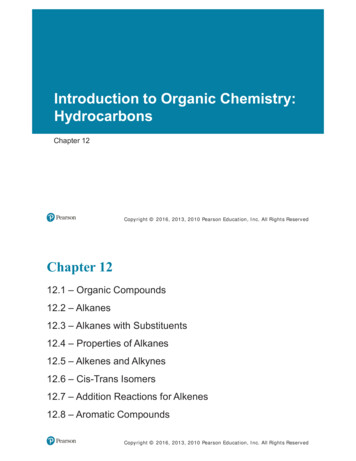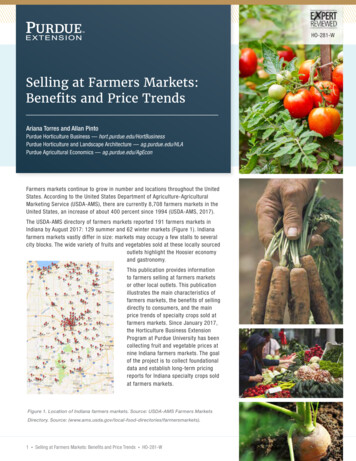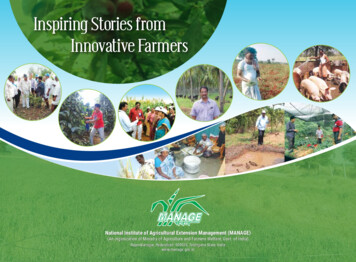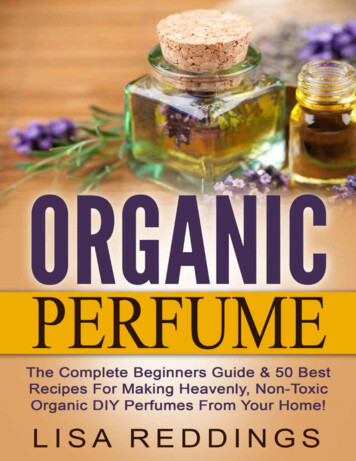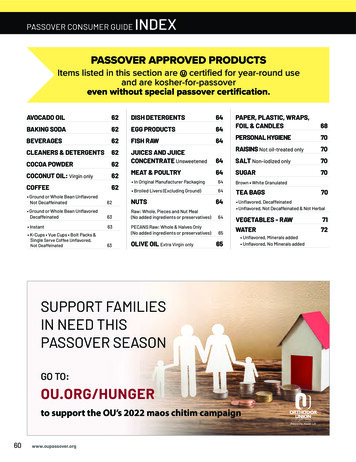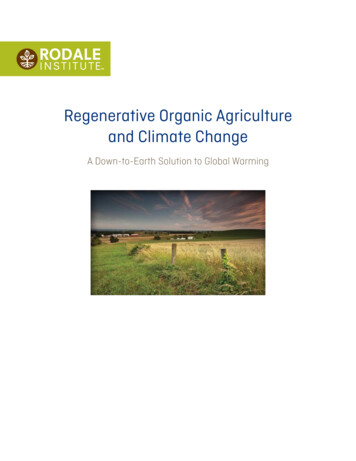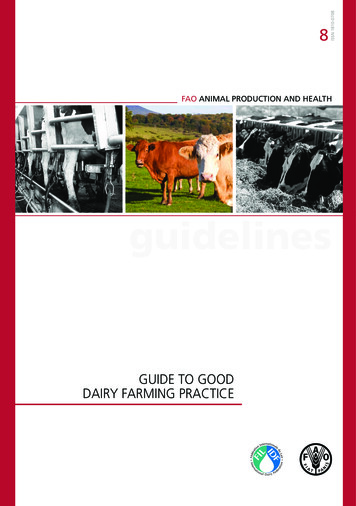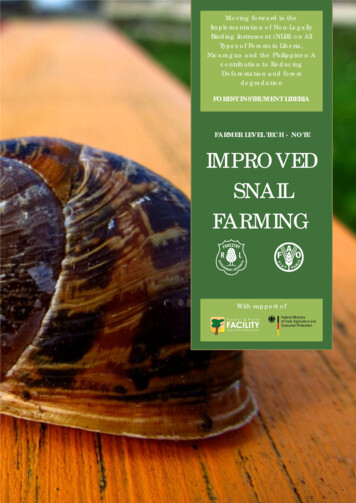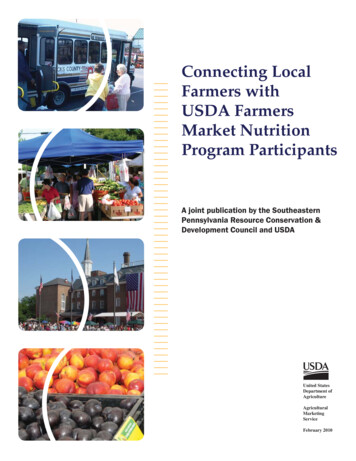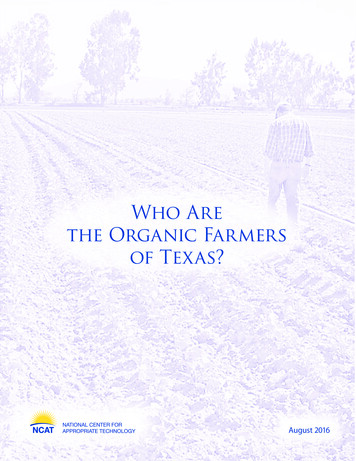
Transcription
Who Arethe Organic Farmersof Texas?August 2016
Project TeamAuthorsResearchersLayout & GraphicsMike MorrisTravis SchattleLillie MarquezRobert MaggianiKevin EllisDebbie Raskncatsw@ncat.orgJustin DuncanAmy Smith1-866-319-1669Copyright 2016 National Center for Appropriate Technology3040 Continental DriveP.O. Box 3838Butte, MT tropiculAgric ture ReseanicaghrcThis report is a product of theSubtropical Organic Agriculture Researchpartnership led by theUniversity of Texas Rio Grande Valley.alOrAll rights reserved. No part of this publication may be copied or reproduced in any form, by means graphic, electronic,mechanical, or otherwise, without written permission of the National Center for Appropriate Technology.Funding to develop this publicationwas provided by theOrganic Transitions Program of theNational Institute of Food and Agriculture,U.S. Department of Agriculture,under award number 2013-51106-20970.The views and opinions expressed in this publication do not necessarily reflect those of the funder, the United Statesgovernment, or any Federal or State agency.While every precaution has been taken in the preparation of this document, neither NCAT, nor the authors, nor the funderassumes any liability for any loss or damage caused or alleged to be caused, directly or indirectly, to any person or entity by theinformation or instructions contained in this book. Reference to any specific commercial product, process, company, individual,or service does not imply endorsement, recommendation, or favoring.AcknowledgmentsMany people helped us understand organic farming in Texas and the collection and reporting of USDA statistics.We’d especially like to thank:Sue Beckwith, Texas Center for Local FoodAnwar Garza, Plantation Produce CompanyGina Geffrard, NASS Survey Administrator, USDA National Agricultural Statistics ServiceFred Granja, Agricultural Statistician, USDA National Agricultural Statistics ServiceDennis Holbrook, South Tex OrganicsMary Ellen Holliman, Organic Program Director, Texas Department of AgricultureBrenton Johnson, Johnson’s Backyard GardenSusie Marshall, Executive Director, Texas Organic Farmers & Gardeners AssociationJoe Masabni, Texas A&M AgriLife Research & Extension Center at OvertonJed Murray, Tenaza OrganicsAlex Racelis, University of Texas Rio Grande ValleyPedro Schambon, My Father’s FarmPeggy Sechrist, Sechrist RanchJennifer Tucker, Associate Deputy Administrator, USDA Agricultural Marketing ServicePaul Wolff, Policy Specialist, National Sustainable Agriculture Coalition
Table of ContentsIntroduction. 1How Many Are There?. 1How many farms are there in Texas?. 1How many organic farms are there in Texas?. 1How do NASS and AMS arrive at their estimates?. 1Which USDA estimate should we believe?. 1Where does Texas rank among states?. 2Executive SummaryOrganic farming in Texas has struck many observers asstunted or underdeveloped, but published estimatesand descriptions of this sector have varied widely.This report reviews all available USDA data—including newlyavailable reports and tools —to arrive at an accurate picture oforganic farming in Texas.More About Texas Organic Farms. 3We conclude that there are at most 305 certified organic cropand livestock operations in Texas, although many of these arevery small and probably less than 200 farms have sold anyorganic products at all in recent years.What crops do they grow?. 3Where are they located? . 3How large are these farms? . 5How many grow specialty crops?. 5Some demographics. 8Is the number of organic farms increasing or decreasing?. 8Who certifies organic operations in Texas?. 9About two thirds of these farms raise field crops and Texas is anational leader in organic cotton, rice, and peanuts, but Texashas a lower percentage of certified organic farms than anyother state and the number of organic farms has not changedmuch in the past decade. Only 61 farms of any size aregrowing organic specialty crops. These farms are experiencinghigh turnover and their number may be decreasing.Opportunities and Challenges. 9Consumer demand. 9What is the dollar value of organic products?. 9How do organic farms market their products?.10What are the main production challenges?.10Resources and Growth Potential. 10How much organic produce can Texas grow?.10How many sustainable farms are there in Texas?.11Are conventional growers open to organic farming?.11How much organic research is taking place?.12What federal programs are available?.13Will crop insurance be a game changer?.13What organic farming associations exist in Texas?.14Recommendations. 15The gap between consumer demand and the supply of Texasgrown organic food is wide and growing. Texas consumersspend over a billion dollars per year on organic food, andonly a tiny percentage of this is grown within the state. Thisrepresents a large missed economic opportunity.Around half of Texas producers are open to the idea oforganic farming and thousands of farms are already using atleast some organic methods. However, the higher prices fororganic products alone have not been enough to convincemost producers to become certified. They will need moretechnical and financial support from universities, agencies, andother institutions before they are willing to attempt the riskytransition process.Overall, the level of institutional support for organic farming inTexas is low compared to other states. While many resourcesalready exist in the state, most of these are under-utilized.Retailers can help by accepting the fact that organic producegrown in Texas will never be as cosmetically perfect as thatgrown in California. New crop insurance options for organicfarms are an extremely promising development. There aremany other steps that could be taken to stimulate the growthof the Texas organic sector.
IntroductionHow many organic farms are there inTexas? Where are they located, whatare they growing, and why aren’t theremore of them?Published accounts and estimates have been “allover the map,” creating distorted or exaggeratedimages of the Texas organic sector. In this reportwe use new USDA data and tools to arrive at anaccurate description of the number, location, andtypes of organic farms in Texas. We characterizethe market for organic food products, surveyresources available to support growth, and offerrecommendations for enabling Texas organicfarming to reach its full potential.How Many Are There?Counting farms is extremely difficult andnot really an exact science. Farms oftenchange names and owners. They mayconsist of geographically dispersed plots of land,some or all of which may be leased from otheroperators. It might not be obvious whethersomething is a farm or merely a garden. Anddetermining that something is a farm requiresknowing facts about business ownership andcontrol that operators may be reluctant todisclose or just too busy to explain.How many farms arethere in Texas?The United States Department of Agriculture(USDA) defines a farm as “any place from which 1,000 or more of agricultural products wereproduced and sold, or normally would havebeen sold” in a given year (NASS, 2012c).1 Basedon this definition, the most recent survey fromUSDA’s National Agricultural Statistics Service(NASS) estimated that there were 248,809 farmsin Texas, more than twice as many as any otherstate (NASS, 2012a).This number may be somewhat deceiving,however, since almost three quarters of theseoperations were very small, selling less than 10,000 per year in agricultural products. Andabout two thirds were livestock operationsmore commonly called “ranches” in Texas—often just a few cattle kept to qualify forlow agricultural property tax rates.2.How many organic farmsare there in Texas?In this report we use the term organic (or certifiedorganic) to refer to agricultural operations thathave gone through the regulatory process of theUSDA’s National Organic Program (NOP). Unlikelegally meaningless terms such as “chemicalfree,” “all natural,” or “naturally grown,” the term“organic” is legally protected and its use requiresmeeting strict USDA standards (Baier, 2005).The various USDA sub-agencies that reporton farming are somewhat notorious for usingdifferent definitions, changing methods fromyear to year, and contradicting each other.3Within the past ten years NASS estimates ofthe number of organic farms in Texas haveranged from 133 to 660 while NASS estimatesof the number of farms transitioning to organicproduction have varied from 19 to 906.4 It’sno wonder so many people are confusedabout the size of the Texas organic sector.There weresomewherebetween 178and 305 certifiedorganic livestockand farmingoperations inTexas in 2014.The most recent NASS estimate counted 178certified organic farms in Texas in 2014 (NASS,2016)5 while USDA’s Agricultural MarketingService (AMS) listed 305 organic operationsin Texas in that same year (AMS, 2016). Thediscrepancy between these estimates was widerin the case of Texas than almost any other stateand calls for some kind of explanation.6How do NASS and AMSarrive at their estimates?NASS conducts a mail-out survey of farms—the Census of Agriculture—every five years,most recently in 2002, 2007, and 2012. In 2008,2011, and 2014 NASS also did special surveys oforganic farms.7 To correct for various errors anddata gaps—the response rate was 63 percentin 2014—NASS uses complicated statisticalmethods.8AMS runs the National Organic Program,maintains a registry of certified operations, andgets its information from the certifying agencies,which submit reports on the operations theyhave inspected. In 2015 AMS rolled out a newOrganic Integrity Database that is edited directlyby the certifying agencies.9Which USDA estimateshould we believe?Why are the NASS and AMS estimates for Texasso far apart? Here are three possible reasons:Who are the Organic Farmers of Texas?Page 1
In the overallpicture ofTexas agriculture,organic farms areneedles in a verylarge haystack.1. Information in the Organic Integrity Database isself-reported and not ordinarily checked by AMSfor accuracy.10 There is considerable variation inhow operations are described, including farmsthat appear to be listed multiple times and otheranomalies related to ownership and control thatcould inflate the number of operations listed.Because of crop rotations and the need to planfor future contingencies, farms may be certifiedfor crops that they are not currently growing.11We also found clear errors such as crops listed inthe livestock category and vice versa.2. The AMS Organic Integrity Database is notstrictly a list of farms but a list of operations.12 Afarm can have more than one organic operation(such as crops and livestock) and sometimesthese are listed separately in the database.3. The NASS 2014 survey took place in the fourthyear of a drought in Texas, and some farms mayhave reported no production, causing them tobe left out of the NASS estimate of 178.13Taken together, these three points seem to implythat the AMS estimate of 305 approximatesthe total number of Texas operations that werecertified to raise organic crops and livestockin 2014, but the lower NASS estimate of 178 isprobably closer to the number of farms thatactually grew and sold these products in 2014.In this report we sometimes use NASS and inother places use AMS as our source. Becauseneither NASS nor AMS provides complete dataon crop acreage,14 we also sometimes rely onolder reports from the USDA Economic ResearchService (ERS). To avoid confusion, note that theNASS 2014 Organic Survey was published in theyear 2016 and so is cited here as “NASS, 2016.”Where does Texas rankamong states?Page 2Table 1: Top states in number oforganic farms# CertifiedOrganicFarms% of 1,1281.62%New .55%Indiana2510.43%Illinois2150.29%North e: NASS, 2016 (Table 28)Table 2: Top states in certifiedorganic Wisconsin226,056New York210,871Oregon203,555North Dakota134,632Based on the NASS 2014 Organic Survey, Texasranked #17 in the number of organic crop andlivestock operations, #6 in total value of organicagricultural products sold ( 199 million) and #9in total organic acreage (NASS, aho125,011While these rankings may sound good, organicfarming is strikingly rare in relation to the totalnumber of farms. Only about one in every1,400 Texas farms is certified organic, a farlower percentage than in any other state. Asshown in Table 1, the equivalent percentage is50 to 100 times higher in strong organic stateslike California, Maine, or Vermont. In the overallpicture of Texas agriculture, organic farms aretruly needles in a very large ebraska110,145Iowa97,186Pennsylvania96,958Source: NASS, 2016 (Table 1)Who Are the Organic Farmers of Texas?
Where are they located?More About TexasOrganic FarmsWhen the average person pictures anorganic farm they may think of a placethat is growing fruits and vegetables.Most organic farms in Texas do not fit this image,as around two thirds of them grow mainly orsolely field crops such as rice, hay, corn, wheat,peanuts, or cotton.What crops do they grow?Some commonly grown crops are shown inTable 3 below. Note that many farms grew morethan one of these crops.Table 3: Some organic cropsgrown in Texas in 2014Crop# FarmsAll field crops118All vegetables, potatoes, & melons52*Cotton36Rice34All fruits, tree nuts, and berries26Lettuce20*Herbs (fresh cut)19*Onions (all varieties)19Peanuts19Wheat (all varieties)19Tomatoes (fresh)Below are notes on a few important crops.Acreage is not reported for most of thesecrops by either NASS or AMS, so acreageinformation in this section comes from theUSDA Economic Research Service (ERS,2013)and is based on the 2011 growing season.Cotton: Texas grows almost all the organiccotton in the United States: with 10,807acres making up 90 percent of U.S. acreage(ERS, 2013). The great majority of productiontakes place in Texas AgriLife Extension ServiceDistricts #2 (South Plains) and #7 (West Central),where a rare combination of favorable factorsincludes low humidity (reducing pest anddisease problems) and reliable frosts that killcotton plants and desiccate the leaves withoutthe need for chemicals. The Texas OrganicCotton Marketing Cooperative has about 40members, many of whom have limited or noirrigation water, causing wide variations in yieldfrom one year to the next (TOCMC, 2016). Inaddition to cotton, members also grow othercertified organic crops such as corn, peanuts,wheat, or milo, and sell organic cottonseed toorganic dairies as feedstuff.Texas leadsthe nation inorganic cotton,peanut, and riceacreage, but fruitand vegetableproduction ismodest.Figure 1: Texas AgriLife Extension Service District numbers19*Squash (all varieties)18Hay (all varieties)17Cabbage (all varieties)16*Corn for grain or seed15Bell peppers13Carrots12Chicken, layers10Garlic10Potatoes10Sorghum10Cattle & calves9Spinach9Snap e: NASS, 2016 (Chapter 2)* Includes both open field and greenhouseproducers. Some farms use both methods.Who are the Organic Farmers of Texas?Source: Texas A&M AgriLife ExtensionPage 3
Peanuts: Texas grew 4,825 acres of organicpeanuts in 2011, 95 percent of all U.S. acreage(ERS, 2013). The 50 farms in Texas certified togrow organic peanuts are mostly in Districts#2 and #7, where (as with cotton) low humidityallows peanuts to be grown without chemicalfungicides.15There are noorganic beefslaughteringfacilities in Texas,so organic cattleleave the statefor processingor are sold atconventionalprices.Rice: Texas ranked #1 in organic rice acreage(19,890) in 2011, accounting for 41 percent ofU.S. acreage and slightly ahead of California(18,393 acres) (ERS, 2013). Organic rice is onlygrown in Districts #9 and #11 (Southeast andCoastal Bend). Production declined greatlyduring the 2011-2014 drought but has resumed.Corn: In 2011 Texas grew 17,006 acres of organiccorn, mostly in Districts #2 and #7 (South Plainsand West Central), but also in District #11 (CoastalBend) (ERS, 2013).Wheat: In 2011 Texas grew 15,745 acres oforganic wheat, about five percent of thenation’s acreage. Organic wheat is grownmostly in Districts #1, #2 and #7 (Panhandle,South Plains, and West Central) (ERS, 2013).Fruit trees and tree nuts: In 2011 Texas had3,826 acres of organic fruit trees and tree nuts.Almost all of this was pecans, with just 109acres of peaches, cherries, and other stonefruits combined, along with 108 acres of citrus(ERS, 2013).16 Most production takes place inDistricts #10, #11 and #12 (Southwest, CoastalBend, and South), but there is also a sizeableacreage of organic pecans in Districts #6(Far West) and #2 (South Plains).Livestock: In 2011 Texas ranked #1 amongstates in number of organic beef cattle (45,790),#2 in organic sheep and lambs (837), and #4in organic dairy cattle (24,101). Out of 31 Texaslivestock operations listed in the AMS OrganicIntegrity Database at the time of publication,most are dairies (13) or egg-laying operations(12), along with a few producing broilers (5)(AMS, 2016).17 There are currently no organicbeef slaughtering facilities in Texas, so organicbeef cattle either leave the state for processingor are sold at conventional prices.18Vegetables: In 2011 Texas reported just 1,335acres of vegetable production (less than onepercent of U.S. acreage), with most of this inDistricts #10, #11 and #12 (Southwest, CoastalBend, and South) (ERS, 2013). South Texas onceprovided a high percentage of the nation’svegetables during the winter, but globalcompetition now makes fruits andFigure 2: Texas organic farmsvegetables available year-roundfrom other places.cotton & peanutsriceSource: AMS, 2016Page 4Who Are the Organic Farmers of Texas?
How large are thesefarms?How many growspecialty crops?The NASS 2014 Organic Survey found that aquarter of the organic farms in Texas sold lessthan 10,000 worth of organic products annually,while half of them reported organic productsales over 100,000. Note that many farms sell amix of organic and conventional products, so afarm selling less than 10,000 worth of organicproducts is not necessarily a small farm.The term specialty crop includes fruits, vegetables,tree nuts, flowers, nursery plants, and honey.NASS does not track specialty crops as a category,and certifiers vary widely in the ways that they listthese crops in the Organic Integrity Database. So ittakes some interpretation to arrive at an estimate.Table 4: Organic product salesby Texas organic farmsSales# FarmsLess than 1,0001920 1,000 to 2,49912 2,500 to 4,99916 5,000 to 9,99911 10,000 to 19,99915 20,000 to 24,9991 25,000 to 39,9997 40,000 to 49,9999 50,000 to 99,99925 100,000 to 249,99938 250,000 to 499,99926 500,000 or more54We went through the Texas operations in theOrganic Integrity Database line by line, checkedfor obvious errors and duplicates, and thenresearched every likely specialty crop farmusing farm websites, phone calls, and personalinterviews.Using this method (in August 2016) we foundjust 61 Texas farms certified by the USDA togrow organic specialty crops. They are shownin Figure 3 below (approximate locations)and listed in Table 5 on the following pages.These 61 farms—many quite small—representthe entire supply of certified organic fruits,vegetables, and tree nuts from the state ofTexas. And there are currently only 40 farms ofany size certified to grow organic vegetables.20TOTAL234Source: NASS, 2016Just 61 Texasfarms—manyquite small—represent theentire supply oforganic fruits,vegetables, andpecans from thestate of Texas.Figure 3: Organic farms growing specialty cropsIncludes both certified organic and exemptoperations with organic product sales 5,000.Source: AMS, 2016Who are the Organic Farmers of Texas?Page 5
Table 5: Texas organic farms growing specialty crops in 2016Operation NameSpecialty CropsCityCertifierAbe FroeseChiles, JalepeñosSeminoleNMDAAdams Blackland PrairiePecansLadoniaNICSAloe Laboratories, Inc.Aloe VeraHarlingenTDAAnimal FarmVegetables (14)Cat SpringTDAANT JVPeasShallowaterTDAApple Country OrchardsApples, PeachesIdalouNICSBenjamin T. MenixPeasLamesaTDABerry Best FarmBlueberriesLarueTDABurrill Farms LLCMixed VegetablesHoustonOTConstanzo Farms Inc.Vegetables (7)AtascosaTDACountry Grown ProduceVegetables (20), Cantaloupes, WatermelonsRock SpringsOCIDay Star Organic Farm, LLCFruits, Mixed Fruit, Mixed VegetablesGeorgetownCCOFDoodley Dee's FarmsVegetables (10)KarnackOCIDos Brisas RanchFruits, Herbs, VegetablesBrenhamQCSEarth Harmony OrganicsVegetables (4), Fruit and Nut Trees, BerriesHuntsvilleCCOFEugene MartinezVegetables (33), Fruits (4), PecansPleasantonNICSGearhart FarmsGrapefruitsMcAllenTDAGenes Greens, LPVegetables (10)ColleyvilleTDAGoebel Organics Inc.Peas, Radishes, RosemaryColorado CityTDAGorma OrganicsGreen beansDalhartNMDAGreen Gate FarmsVegetables (40), MelonsAustinNICSGreen Texan Organic FarmsVegetables (11), MushroomsPlanoTDAGundermann Acres LLCVegetables (30), Cantaloupes, WatermelonsWhartonTDAH2O OrganicsVegetables (15)HockleyOCIHacienda CaujomulcoPecansUvaldeAIHairston Creek FarmVegetables (20), StrawberriesBurnetTDAJacky D MorrisonVegetables (11), Cantaloupes, WatermelonsO'BrienOTJeff NickersonBroccoli, StrawberriesBryanJohn L LackeyGrapefruits, LimesWeslacoTDAJohnson’s Backyard GardenVegetables (55), Fruits (5)Cedar CreekNICSJones and Naegelian, JVGreen beansDilleyNICSNICSSource: AMS, 2016Key to certifiersAI Americert InternationalCCOF California Certified Organic FarmersKBCS Kiwa BCS Oko Garantie GmbHNICS Nature’s International Certification ServicesNMDA New Mexico Dept. of AgricultureONE OneCert IncOI Organic Crop Improvement AssociationOT Oregon TilthPL Primus LabsQCS Quality Certification ServicesTDA Texas Dept. of Agriculture.Page 6Who Are the Organic Farmers of Texas?
Table 5: Texas organic farms growing specialty crops in 2016 (cont’d)Operation NameSpecialty CropsCityCertifierKDJ Farms, LLCPecansCanutilloCCOFL&L Farms LLCSpinachFrioTownNICSLarsen FarmsPotatoesDalhartOCILeafy Creek FarmVegetables (33), Fruit (10), PecansGustineNICSMid Valley Agriculture, LLCVegetables (5)La FeriaTDAMimosa FarmsGreen beansSan AntonioNICSMy Father's FarmVegetables (28), CantaloupesSeguinCCOFOnion Creek FarmVegetables (11)Dripping SpringsTDAOportunidads Golpe Inc.WatermelonsMeadowTDAK BCSPlantation Produce (PPC Farms)Vegetables (10)MissionPure Luck Inc.Vegetables (10), Fruits (5)Dripping SpringsRainbow GreensVegetables (14)AustinTDAAIRichard And Stacy Carter FarmsAvocadosMuleshoeOCIRio Grande OrganicsPecansCrystal CityQCSRoyal Pecans s LLCPecansEagle PassQCSRyan FarmBlack Eyed PeasBig SpringONESouth Tex Organics LCVegetables (8), Fruits (3), Citrus (4)MissionTDASoutheast Texas OliveOlivesWinnieCCOFStrohmeyer Family Farm LLCCitrus (6)McAllenTDATecolote FarmHerbs & Vegetables, Strawberries, Blackberries ManorNICSTenaza OrganicsVegetables (18)MissionNICSTerra Preta FarmVegetables (35), WatermelonsWeslacoNICSTexas Hill Country Olive Co.OlivesDripping SpringsTDATexas Organic MushroomsMushroomsDenisonTDAThompson Citrus GroveGrapefruitsWeslacoNICSTim MillerVegetables (30), Fruits (5), PecanKyleNICSTriple J OrganicsGrapefruits, OrangesMissionTDAVal Verde Vegetable Co. Inc.Vegetables (4)McAllenPLWhispering Hills Pecans Orchard Inc.PecansHuntsvilleTDAYahweh’s All Natural Farm & GardenVegetables (27), Fruits (12), Citrus (5), PecanSource: AMS, 2016HarlingenNICSKey to certifiersAI Americert InternationalCCOF California Certified Organic FarmersKBCS Kiwa BCS Oko Garantie GmbHNICS Nature’s International Certification ServicesNMDA New Mexico Dept. of AgricultureOCI Organic Certifiers, Inc.ONEI OneCert IncOT Oregon TilthPL Primus LabsQCS Quality Certification ServicesTDA Texas Dept. of Agriculture.Who are the Organic Farmers of Texas?Page 7
Some demographicsIs the number of organicfarms increasing ordecreasing?Demographic information about Texas organicfarms is not always useful because it lumpstogether very different groups. Farms growingprimarily field crops tend to be larger and sellmainly to wholesalers, while those growingspecialty crops tend to be smaller and aremore likely to sell directly to consumers.There hasbeen littlegrowth in thenumber oforganic farmsover the pastdecade and highturnover amongspecialty cropfarms.The 2012 Census of Agriculture found that: 83% of Texas organic farmers were male and17% were female. Their average age was 53.9. They had been on their present farm for anaverage of 16 years. 65% had farming as their primary occupation. 64% lived on the farm they operated. 55% worked 200 days or more off the farm.Based on these numbers, there appears tohave been consistent growth in the numberof organic farms from 2000 through 2008, butlittle if any growth since that time. The numberseems to have dipped and then recoveredover the past decade, staying in the range ofapproximately 220 to 300.Table 7: Age of Texasorganic farmersAgeTable 6: Years involved incertified organic production% of Farms 5 years275 to 9 years42 10 years31TOTALFigure 4 below shows the number of certifiedorganic crop and livestock operations reportedby ERS (from 2000 to 2011) and AMS (from 2010to 2016). Because of comparability problems—such as changing reporting methods anddefinitions from year to year—these numbersmust be viewed as only approximate, but theyare all we have from USDA.21100%Source: NASS, 2012PercentageUnder 251.2%25 to 347.2%35 to 4415.3%45 to 499.0%50 to 5415.3%55 to 5918.5%60 to 6414.2%65 to 699.8%Over 709.5%TOTAL100%We also looked closely at the number oforganic specialty crop farms, and here we foundevidence of a recent decrease. In an earlierreview of AMS 2014 data, NCAT identified 75certified organic specialty crop farms in Texas(Maggiani & Morris, 2015). Now we count only61 of these farms—a decrease of 14 between2014 and 2016.Moreover, we learned that the turnover rateamong organic specialty crop farms has beenextraordinarily high. Just 33 of the 75 farmsthat we identified in 2014 AMS data—less thanhalf—are still shown as growing specialty cropstwo years later in the AMS Organic IntegrityDatabase. Between 2014 and 2016, 42 farmsfell off the list of organic specialty crop farmsand 28 new farms appeared on the list.22Source: NASS, 2012TexasorganicOrganic crop and livestock operationsFigure 4: Number of Texas certified350300ERS data250200AMS 08200720062005200420032002200120001999-Source: AMS and ERS (multiple years)Page 8Who Are the Organic Farmers of Texas?
Who certifies organicoperations in Texas?In 2015, 80 organizations were accredited by theNOP to issue organic certification to growers,processors, and handlers. Of these, 23 wereactive in Texas and are shown in Table 8.Until recently the Texas Department ofAgriculture (TDA) ran the most popularinspection program in Texas, but for the firsttime in 2015 Nature’s International CertifyingServices certified the most organic operations(AMS, 2016). Within the past few years there hasbeen a migration away from TDA and towardsprivate certifiers.23Table 8: Certifying agencies active in TexasA Bee OrganicAmericert InternationalECOCERT ICOGlobal Organic Alliance, Inc.Kiwa BCS Oko Garantie GmbHNatural Food CertifiersNew Mexico Department of AgricultureOregon Tilth Certified OrganicOrganic Crop Improvement AssociationQuality Assurance InternationalSCS Global ServicesTexas Department of AgricultureAgricultural Services Certified OrganicCCOF Certification Services.Global CultureInternational Certification Services, Inc.Mayacert S.A.Nature’s International Certification Services, Inc.OneCert, Inc.Organic Certifiers, Inc.Primus LabsQuality Certification ServicesStellar Certification ServicesSource: AMS, 2016Opportunities andChallengesTexas retailers buy the vast majorityof organic food from outside of thestate, and the amount grown withinTexas was described to us by one industryexpert as “minuscule.” This represents a missedeconomic opportunity of epic proportions.consumer demandAccording to the Organic Trade Association (OTA),U.S. sales of organic food and non-food productshave grown by double digits every year since the1990s, reaching 43.3 billion in 2015. About 83percent of U.S. families now choose organic foodat least sometimes (OTA,2015).Texasconsumersspend morethan a billiondollars per yearo
ncatsw@ncat.org Justin Duncan Amy Smith 1-866-319-1669 The views and opinions expressed in this publication do not necessarily reflect those of the funder, the United States government, or any Federal or State agency. While every precaution has been taken in the preparation of this document, neither NCAT, nor the authors, nor the funder

